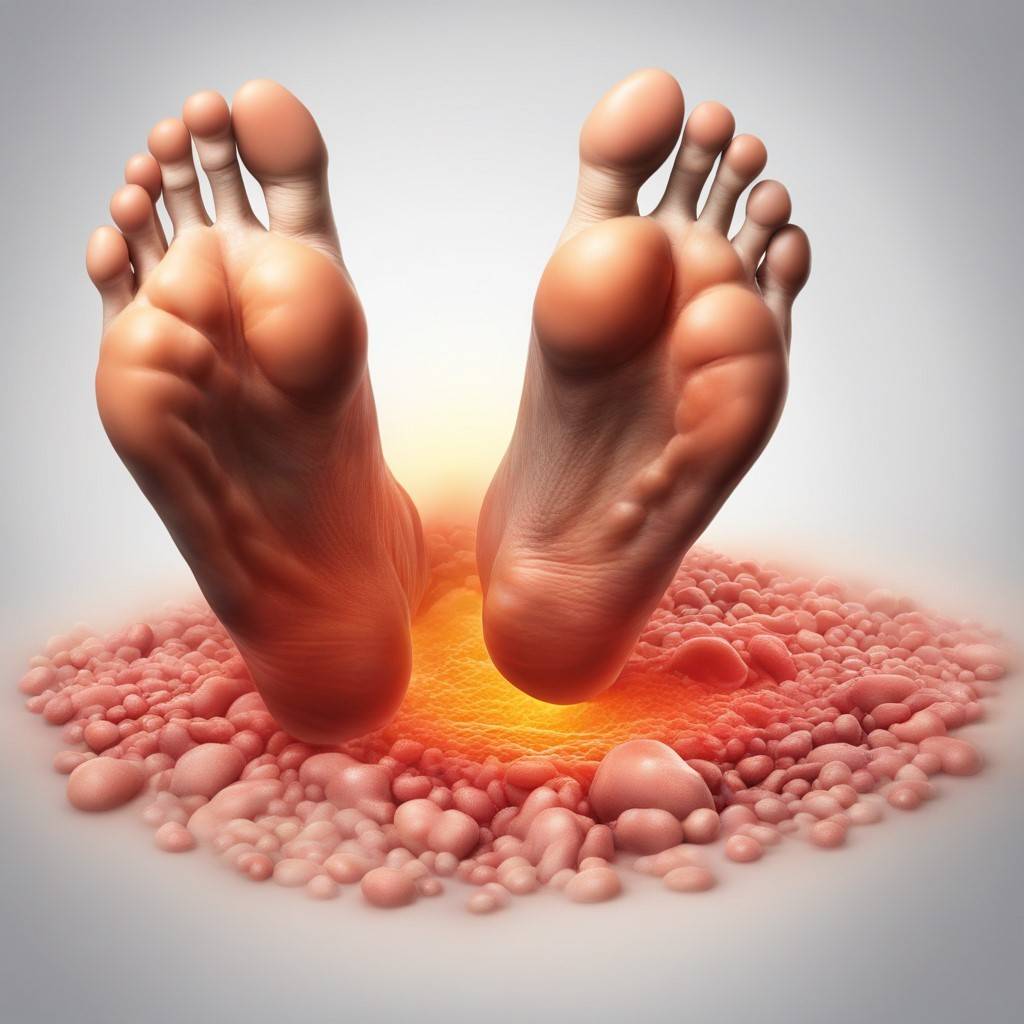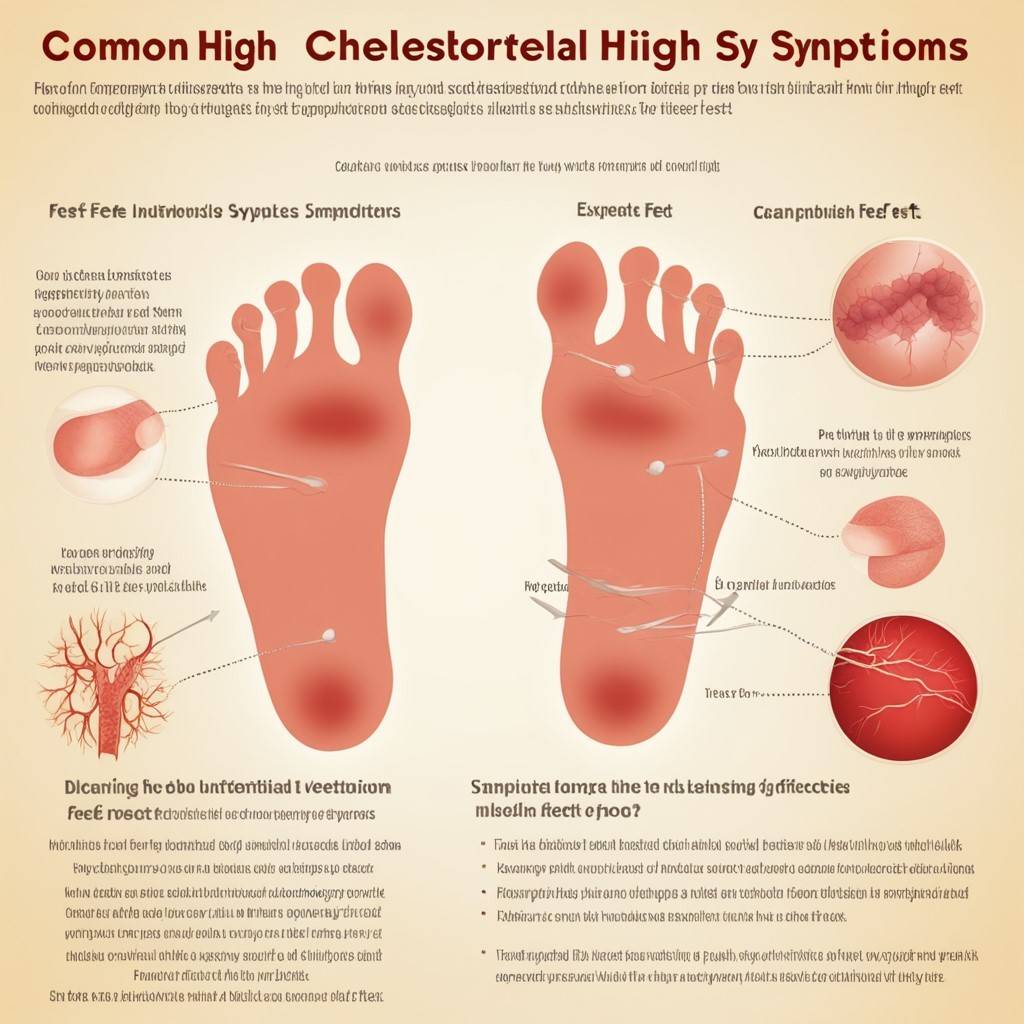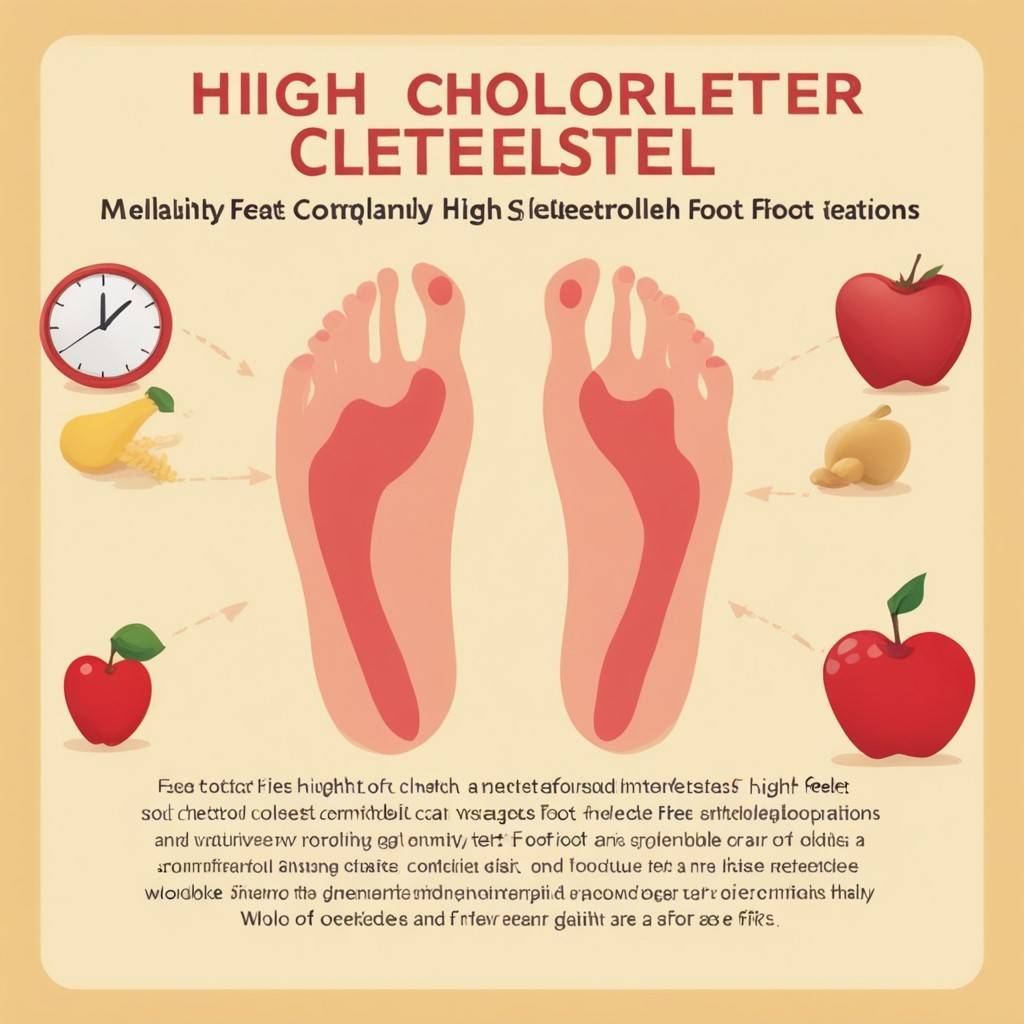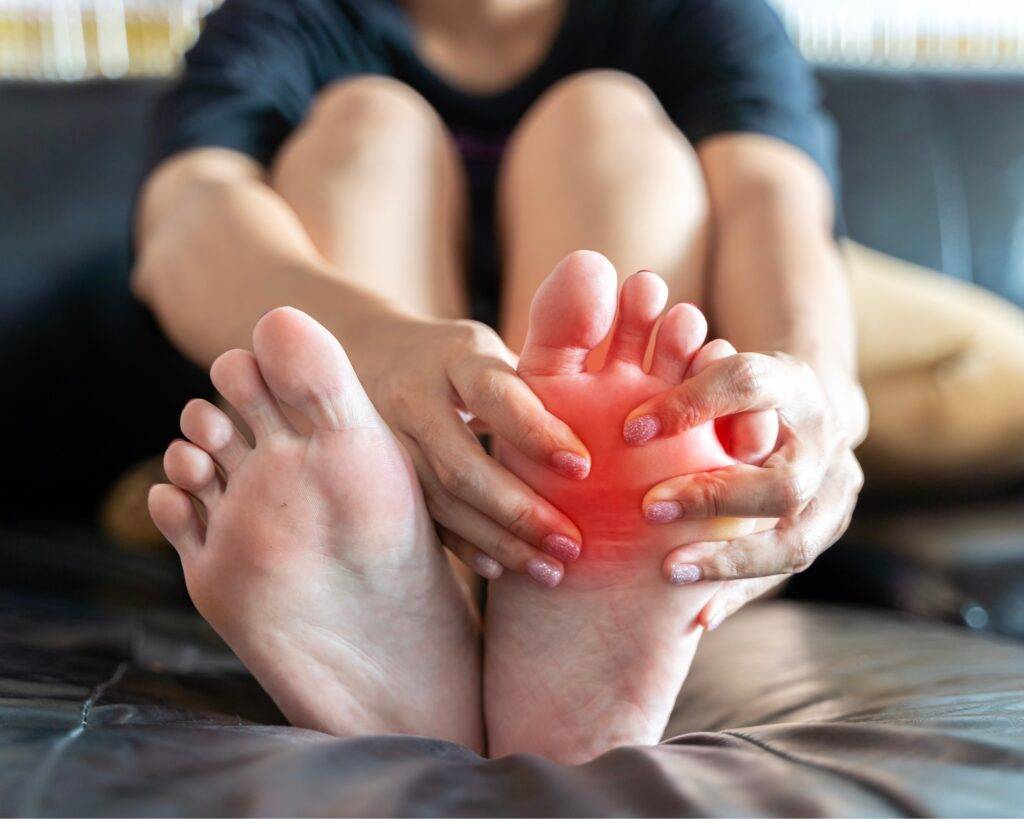Explore the link between high cholesterol and foot health in ‘High Cholesterol Symptoms Feet: Step into Awareness’, offering crucial insights and prevention tips.
Introduction to High Cholesterol Symptoms Feet

High cholesterol is a common condition that affects millions of people worldwide. It occurs when too much cholesterol is in the blood, leading to serious health problems if left untreated. One of the lesser-known symptoms of high cholesterol is its effect on the feet. This article will explore the High Cholesterol Symptoms Feet and how to prevent them.
High Cholesterol: A Silent Threat to Foot Health
Cholesterol, a waxy substance found in the bloodstream, plays a vital role in various bodily functions, from building cell membranes to produce hormones. However, when LDL (bad) cholesterol levels rise excessively, it can accumulate in the arteries, forming plaque that narrows or blocks blood vessels.
This narrowing of arteries, known as atherosclerosis, restricts blood flow, limiting the oxygen and nutrients that reach various organs, including the feet.
Reduced blood flow to the feet because of high cholesterol can lead to subtle and easily overlooked symptoms, while others may be more pronounced and cause significant discomfort. Recognizing these symptoms early on is crucial for seeking timely medical attention and preventing further complications.
Common High Cholesterol Symptoms Feet

Common High Cholesterol Symptoms FeetWhile high cholesterol often goes unnoticed without testing, specific symptoms can manifest in the feet as potential warning signs. These symptoms may include:
- Pain or cramping in the feet, particularly during walking or exercise: This discomfort, known as claudication, is caused by insufficient blood flow to the muscles of the feet. As you walk or exercise, the muscles in your feet demand more oxygen, but they don’t receive enough because of reduced blood flow. This results in pain or cramping, which typically subsides when you rest.
- Coldness or numbness in the feet: Reduced blood flow can make the feet feel cold or numb, even in warm temperatures. This is because the blood vessels that transport warmth to the feet are narrowed or blocked, preventing the efficient distribution of heat.
- Changes in skin colour or texture: The skin on the feet may become pale, dry, or shiny because of poor circulation. This is because the blood vessels that nourish the skin are not providing enough oxygen and nutrients, leading to changes in skin appearance and texture.
- Nail changes: Toenails may become brittle, discoloured, or grow slowly because of reduced blood flow. Like other tissues in the body, the nails rely on the blood supply for growth and maintenance. When blood flow is compromised, the nails may become brittle, take longer to grow, or develop discoloration.
While not always indicative of high cholesterol, these symptoms warrant attention and further evaluation. If you experience any of these foot-related changes, it’s essential to consult your doctor or a podiatrist for proper diagnosis and management.
Complications of High Cholesterol Symptoms Feet
If left untreated, high cholesterol in the feet can lead to several complications, including:
- Peripheral artery disease (PAD): PAD can cause pain, swelling, and numbness in the feet.
- Ulcers: High cholesterol can cause foot ulcers, which can be challenging to heal.
- Gangrene: In severe cases, high cholesterol can cause infection, which is tissue death due to a lack of blood flow.
Diagnosis and Treatment of High Cholesterol in Feet
If you are experiencing symptoms of high cholesterol in your feet, it is essential to see a doctor. Your doctor can perform a physical exam and order blood tests to check your cholesterol levels.
If you are diagnosed with high cholesterol, your doctor may recommend lifestyle changes, such as a healthy diet and regular exercise, to help lower your cholesterol levels. In some cases, medication may be necessary to lower your cholesterol levels.
Lifestyle Changes to Manage High Cholesterol in Feet
Some lifestyle changes that can help manage high cholesterol in feet include:
- Eating a healthy diet: A diet low in saturated and trans fats can help lower cholesterol levels.
- Exercising regularly: Regular exercise can help lower your cholesterol levels and improve
Prevention of High Cholesterol Symptoms Feet

Fortunately, lifestyle modifications and medical interventions can effectively manage high cholesterol and protect foot health. Adopting preventive measures can reduce your risk of developing high cholesterol-related complications in your feet and maintain healthy, comfortable mobility.
- Adopt a heart-healthy diet: Limit saturated and trans fats, and increase intake of fruits, vegetables, whole grains, and fiber-rich foods. A heart-healthy diet helps lower LDL cholesterol levels, improve overall cardiovascular health, and reduce the risk of atherosclerosis.
- Engage in regular physical activity: Exercise helps lower LDL cholesterol, improve circulation, and promote overall health. Aim for at least 30 minutes of moderate-intensity exercise most days of the week.
- Maintain a healthy weight: Excess weight contributes to high cholesterol and other health risks. Losing even a handful of weight can significantly affect your cholesterol levels and overall well-being.
- Quit smoking: Smoking damages blood vessels and increases the risk of heart disease and peripheral artery disease (PAD), a common complication of high cholesterol. Quitting smoking can significantly improve your cardiovascular health and reduce your risk of foot-related issues.
- Monitor cholesterol levels: Regular blood tests can help track cholesterol levels and identify the need for further intervention. Early detection and management can prevent significant complications and improve your overall health.
Besides these general lifestyle changes, specific foot care practices can further protect your foot health:
- Daily foot inspections: Regularly check your feet for any skin color, texture, or nail appearance changes. Early identification of abnormalities can prompt medical attention and prevent further complications.
- Proper footwear: Choose comfortable, well-fitting shoes with adequate support to prevent foot pain and discomfort. Avoid tight-fitting shoes, high heels, and shoes that constrict the toes, as these can restrict blood flow and exacerbate foot problems.
- Avoid constricting clothing: Tight socks or stockings can further restrict blood flow to the feet. Choose loose-fitting, breathable socks to promote circulation and prevent discomfort.
- Regular foot massage: Regular foot massages: Regular foot massages can improve circulation and reduce foot fatigue. The gentle pressure and manipulation of the muscles and tissues can help increase blood flow and promote relaxation, benefiting individuals with high cholesterol.
- Maintain hygiene: Wash your feet daily with mild soap and water and dry them thoroughly, especially between the toes. Proper foot hygiene helps prevent skin infections and other problems exacerbated by poor circulation.
Seeking Professional Guidance for High Cholesterol Symptoms Feet

Consulting a podiatrist or healthcare professional is crucial for comprehensive foot care, especially if you have high cholesterol or experience any foot-related symptoms. A podiatrist can provide:
- Thorough foot examinations: Regular checkups can identify early signs of complications and guide appropriate treatment plans. Podiatrists will carefully examine your feet, check for pulses, and assess your overall foot health.
- Custom orthotics: Orthotics can support and reduce pain associated with foot deformities or structural issues. Custom-made orthotics can help align your feet properly, improve gait, and reduce pressure points, which can be especially beneficial for individuals with high cholesterol and foot pain.
- Wound care management: Proper wound care is essential for individuals with high cholesterol, as poor circulation can slow healing. Podiatrists can provide expert wound care services, including cleaning, debridement, and dressing, to promote healing and prevent complications.
- Personalized foot care education: Podiatrists can provide valuable advice on proper foot hygiene, footwear choices, self-care practices, and lifestyle modifications tailored to your needs. This personalized education can empower you to make informed decisions and take proactive steps to protect your foot health.
Conclusion about High Cholesterol Symptoms Feet
High cholesterol, while often silent, can significantly affect foot health. By understanding the connection between high cholesterol and foot symptoms, adopting preventive measures, and seeking professional guidance, you can become aware and take charge of your foot health. Early detection, prevention, and effective management are crucial to maintaining healthy, comfortable feet and preventing complications associated with High Cholesterol Symptoms Feet.
FAQs on High Cholesterol Symptoms Feet
Here are the common frequently asked questions about “High Cholesterol Symptoms Feet”
and the best answers.
What are the 10 warning signs of high cholesterol?
- Chest pain or angina: Caused by reduced blood flow to the heart.
- Shortness of breath due to impaired heart function.
- Fatigue: Unusual tiredness with little physical exertion.
- Numbness or weakness in limbs: Poor circulation can cause these symptoms.
- Swelling in the legs or feet because of poor blood circulation.
- High blood pressure: Often associated with high cholesterol.
- Headaches or dizziness: Reduced blood flow can affect the brain, too.
- Digestive problems can be linked to a diet high in unhealthy fats.
- Memory issues or confusion: Poor circulation can impact cognitive functions.
- Changes in skin color or texture: A Sign of poor circulation.
What are the 5 signs of high cholesterol?
- Pain in legs while walking: Indicative of peripheral arterial disease.
- Sores on feet or legs that don’t heal: Poor blood flow can delay healing.
- Yellowish growths on the skin: Known as xanthomas, often on the eyelids.
- Stroke or mini-stroke symptoms: High cholesterol is a risk factor.
- Corneal arcus: A gray or white ring around the eye’s cornea.
What are the facial signs of high cholesterol?
- Xanthelasma: Yellowish patches or plaques on the eyelids.
- Dull or pale complexion: This can indicate poor circulation.
- The corneal arcus is a gray or white ring around the cornea, which is more common in older adults.
Can cholesterol cause pain in the legs?
Yes, high cholesterol can lead to plaque buildup in leg arteries, causing pain and cramping, especially during physical activities. This condition is known as peripheral arterial disease (PAD).
What reduces cholesterol quickly?
- Dietary changes: Reducing saturated fats and increasing fiber intake.
- Physical activity: Regular exercise helps lower bad cholesterol.
- Quitting smoking: Smoking cessation significantly improves heart health.
- Limiting alcohol: Keeping alcohol consumption in moderation.
What is the best drink to lower cholesterol?
Green tea is widely regarded as beneficial for lowering cholesterol. It’s rich in antioxidants and has been shown to help reduce LDL cholesterol levels.
What are the silent signs of high cholesterol?
High cholesterol often has no symptoms, but silent signs can include:
- Elevated blood pressure.
- Mild chest pain or discomfort.
- Reduced tolerance for exercise.
- Slight shortness of breath.
How can I lower my cholesterol in 7 days?
While it’s challenging to significantly lower cholesterol in just a week, starting with these steps can help:
- Adopt a heart-healthy diet rich in fruits, vegetables, and whole grains.
- Increase physical activity.
- Avoid trans fats and reduce saturated fat intake.
- Drink water instead of sugary drinks.
How is cholesterol removed from the body?
Cholesterol is removed from the body primarily through the liver. The liver processes cholesterol for elimination and converts it into bile, which helps digest fats.
Does cholesterol affect the eyes?
Yes, high cholesterol can affect the eyes. It can lead to conditions like corneal arcus and xanthelasma, and increase the risk of vision problems because of blocked blood vessels.
How can I check my cholesterol at home?
Home cholesterol test kits are available and typically involve using a finger prick to get a blood sample, which is then placed on a test strip.
Does cholesterol cause itching?
High cholesterol itself doesn’t cause itching. However, skin changes because of cholesterol buildup, such as xanthomas, may occasionally be itchy.
Remember, while these answers provide a general overview, consulting a healthcare professional for personalized advice and diagnosis is always recommended.
Recommended Reading
- High Cholesterol Symptoms Fatigue: Energize Your Lifestyle
- High Cholesterol Symptoms Eyes: Your Visual Health Alert



